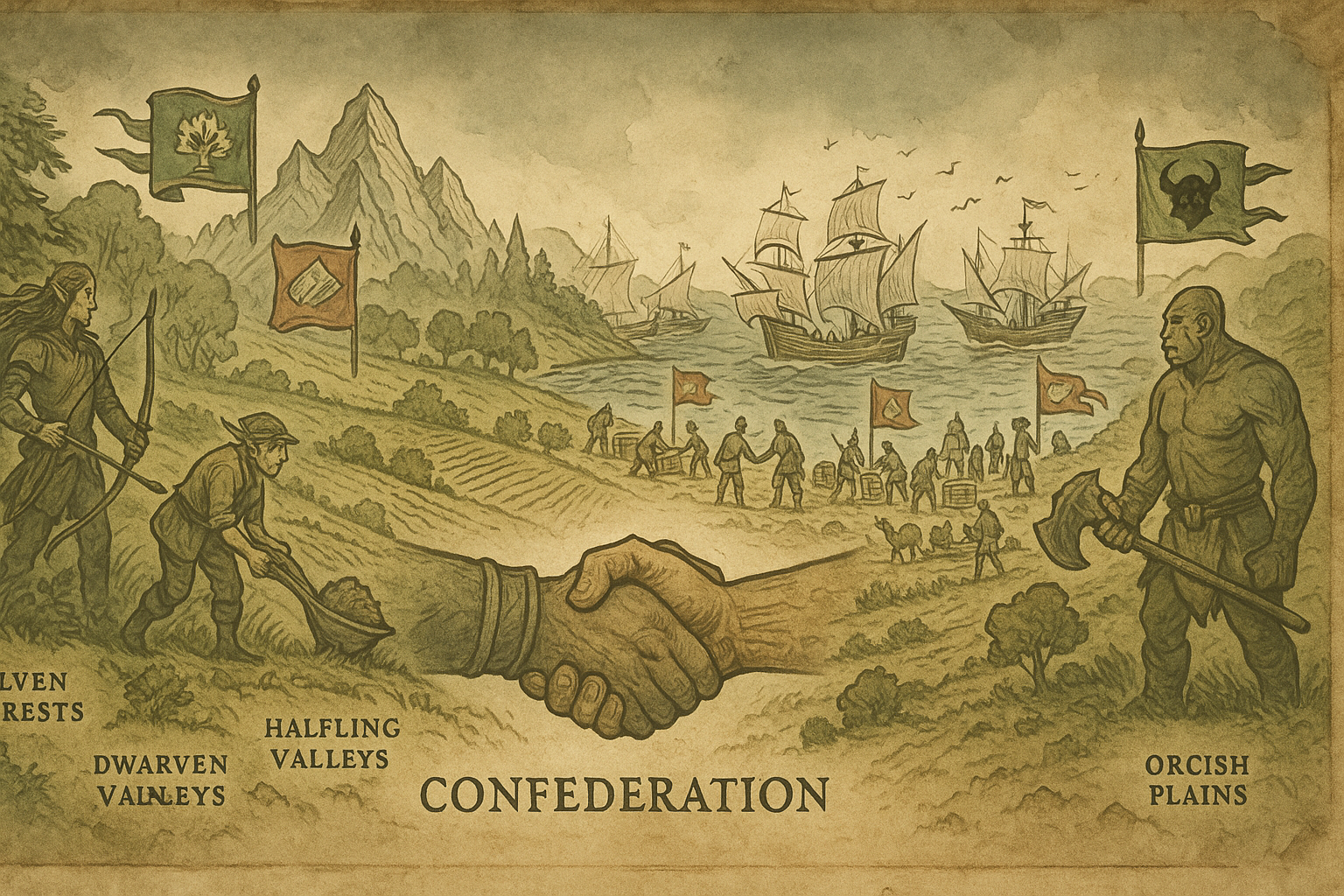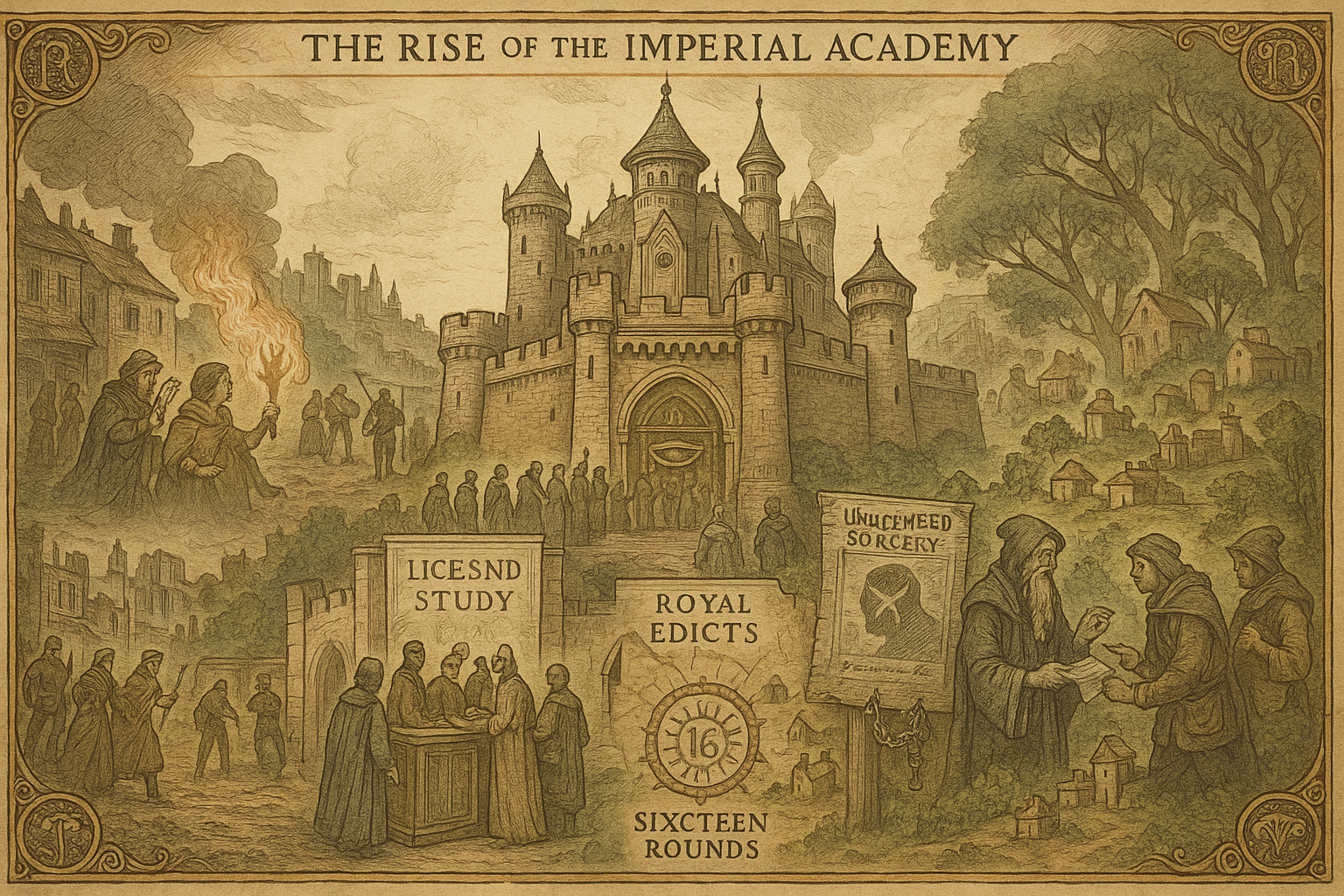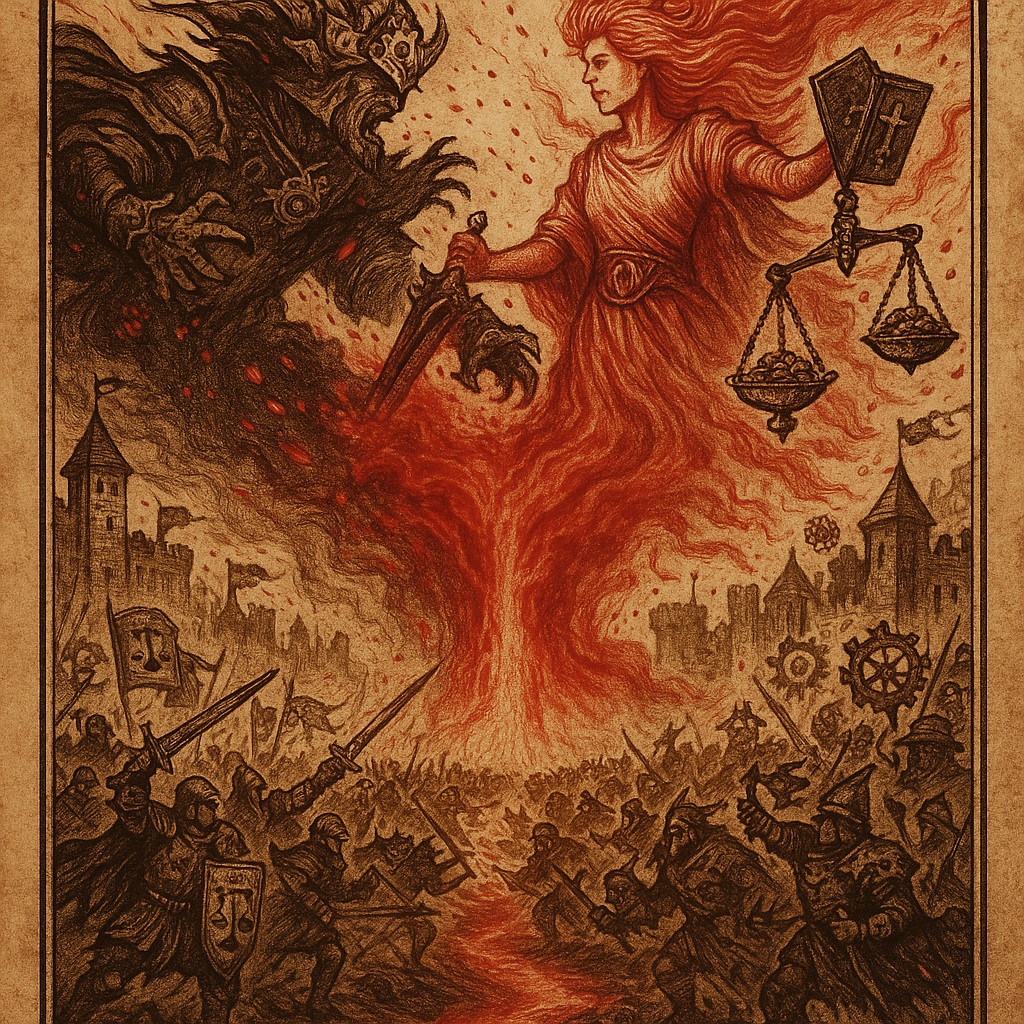Lore & History
A History Forged in Fire
Long ago, before provinces were carved and castles crowned the hills, the land of Thardferr existed in a fragile balance. The native races lived in scattered realms, each guarding their borders with suspicion but little bloodshed. Elves ruled the forests, dwarves held the mountains, halflings farmed the valleys, and orcs roamed the plains.
Then came the humans.
They arrived from across the sea, sailing out of the distant land of Syth. With them came tools and supplies to build a new colony. But they also brought ambition, weapons, and war. Thardferr would never be the same.
Though the humans shattered the peace, they also offered something new. Their leadership and diplomacy helped forge alliances between the races that had never trusted each other. Some alliances broke quickly. Others lasted for generations. When Sythian warlords eventually returned to conquer Thardferr, the native peoples stood side by side for the first time in history.

Elves, dwarves, humans, orcs, and halflings united to form a grand alliance called the Confederation. From scattered villages and crumbling keeps, they built something powerful. Together, they stopped the Sythian invasion and ensured the survival of the continent.
The Rise of the Imperial Academy
Though the Sythian armies were defeated, their mages left deep scars across the land. Magic, once mysterious and rare, became something feared. Civilians associated it with fire, death, and betrayal. In response, the Emperor of the Confederation placed strict limits on its use.
The solution was the creation of the Imperial Academy. Any mage who wished to practice magic legally had to register. They were allowed to study, but only in private. Magic was removed from public life, hidden behind stone walls and scroll-locked vaults.
Over time, the Academy grew more powerful. Its rules became harsh. Many gifted spellcasters refused to register. These unlicensed sorcerers, branded as criminals, became known as illegal mages. Though hunted by the Academy, they lived free, unbound by imperial oaths or wartime conscription.
After the last great war, when most official mages had died on the battlefield, these illegal mages became the only source of magic left in Thardferr. They were no longer feared, but welcomed. Regents began to hire them, asking for their help in rebuilding. They trained new generations of wizards and slowly earned the respect they had long been denied.

The final war left the land broken. Cities were in ruins, and the Confederation could no longer rule as a single force. To restore order, the Emperor offered small parcels of land to the soldiers who had survived the war. Each received a castle, a few buildings, and ten acres of land. Their mission was simple: rebuild Thardferr, protect its people, and bring prosperity back to the realm.
What followed were sixteen great Rounds of strife and rebuilding. Kings rose. Castles fell. The map changed hands more times than bards could count.
The Last Edict and the Long Silence
When the sixteenth Round closed, the Emperor chose to end magic itself. With the Academy’s final circle and a pact few understood, he set the Edict of Unmaking. The weave thinned. Runes went quiet. Wand-light failed.
Old tales say the halfling elders guided the ritual in return for a promise of perfect safety for their children. The price was exile from the waking realm. Their green shires slipped behind a hidden door that mortals call the Halflight, safe and sealed. Those who refused to pass changed over long ages. Craft replaced harvest. Tinker’s wit replaced farmer’s patience. Mischief bloomed. In time, people called these folk Gnomes.
With the weave sealed, war lost its teeth. The world entered thirty thousand years of peace. Empires became memory. Monsters became stories. The Age slowed to a hush so deep that even historians wrote shorter books.
The Stirring
No wall holds forever. First came small things: a candle that burned cold, a rune that would not fade, a dream in which steel sang. In those first cracks of returning power, the Undead began to appear, thin as smoke and stubborn as memory. This was before any god took form.
Then came a prayer.
A warlord named Trupheus, champion of the realms and scourge of his rivals, was broken on all sides. With his banners burning and his vaults emptying, he cried out to anything that would answer.
Something did.
The Two Who Answered
Chaos found a doorway through Trupheus and stepped into the world. Chaos took up gnomish colors, and the gear-and-grin guilds rallied to him. Brass sigils woke. Gears sang. Wit turned cruel. The Undead, already walking since the Stirring, felt his shadow and some fell into his ranks, while others turned against him.
Chaos answered with clockwork nightmares in gnomish boots, with grave-smoke taught to grip a blade, with luck turned inside out.
Balance has its own gravity. Where Chaos plants a flag, Nemesis rises. Some call her the Goddess of Revenge, others the Bookkeeper of Debts. She remembers. When Chaos marched behind gnomish banners, Nemesis stepped also, and the weave fully woke.

Magic returned. So did war. That was the spark of Round 1 of the New Age.
The War by Proxies
Gods could not strike gods. They bound themselves to older covenants and fought by mortal hands. Oaths were sworn. Colors were raised. Markets saw strange requests and stranger tributes.
On the side of Nemesis, a company answered to no king but a promise: debts would be paid. They came to be known as the Agents of Revenge. For two brutal months they hurled themselves at Chaos’s banners, bled on a hundred fields, and kept marching.
Roll of Honor – Agents of Revenge
Vesuvan • Rand al’Thor • Volfenhag • Temo • Zuron • Rennoc • Hanktimus • Scooby Doo • GreatKing • Necromancer • Akroma • Hips
They stood between Chaos and the rest of us, and that is enough.
The Red Accounting

Even gods have limits. The Agents faltered at last, bones and banners mixed on the same carts. Markets filled with grim offerings and blood-price tithes. Some whispered that Nemesis asked for sixty-nine gold a soul so men would remember the jest in the middle of horror. Others said it was the exact weight of an oath.
Nemesis opened the book and called in all debts at once.
The sky blackened. Rain fell like rubies. The Red Accounting burned across river and ridge alike. It swallowed Chaos where he stood, and took Nemesis with him, for she will not write a sum she will not pay. The wave did not spare kings, peasants, horses, or hounds. When it passed, every living thing was ash.
Silence again. Not the old Silence, but the breath before the next word.
Supplemental Artifacts
The Testament of Chaos Padre-Del-Caos
A Farewell to Thardferr – Nemesis God Of Revenge
The New Age
From the ashes, life returned as if poured from a hidden cistern. Fields woke. Workshops clattered. Castles raised their first banners. Peasantry gathered in town squares to be counted, then scattered to work and war. Strange magical items now lie in ruins and riverbeds, echoes of the gods’ brief passage. The Undead linger where the weave tore thin, and along old marches where Chaos once passed, thin as smoke and twice as stubborn.
The world has a new calendar and a new appetite. Rounds will be numbered without end. The map is blank enough for old names and new mistakes. The weave is back, watched but not chained. The Academy keeps its ledgers, though its oaths read differently now. Gnomes, born from the long turn of centuries, stand proudly where halfling shires are only stories. Somewhere, in halls no one admits exist, the halflings keep their bargain and sleep well.
This is the New Age of Thardferr. The gods are gone for now, but their fingerprints are on everything.
